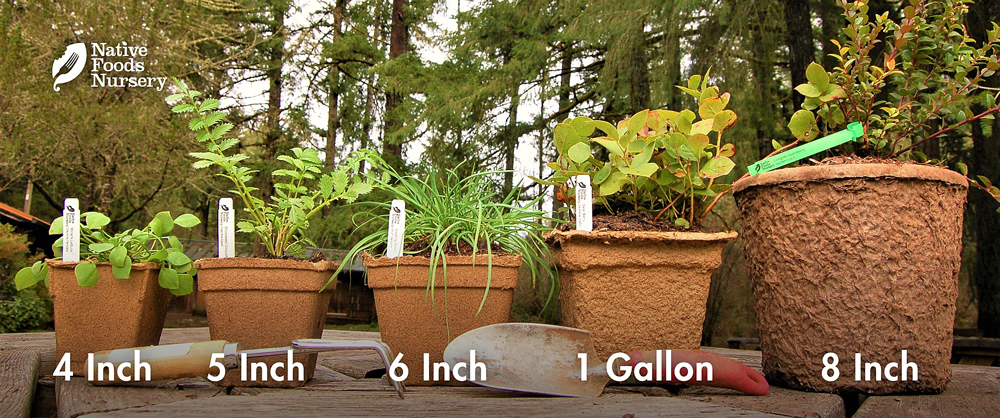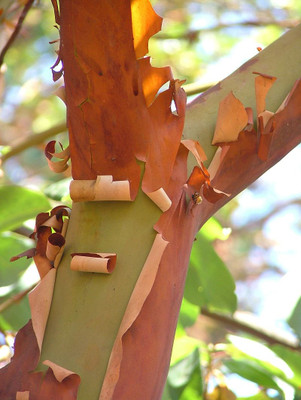Pacific Madrone
- Current Stock:
- 0
- Other Names:
- Madrona, Laurelwood, Arbutus, Oregon Laurel
- Latin Name:
- Arbutus menziesii
Pacific Madrone or Madrona is a prized native evergreen tree with brilliant cinnamon-brown bark, white flower-clusters, and bright red-orange edible fruits.
Edible Uses
Pacific Madrone is a native food with edible bark and berries. The berries can be eaten fresh off the tree, cooked and added to fruit dishes, simmered into a non-alcoholic cider, or dried and stored for future use. The bark can be used to make a refreshing tea.
Expect Madrone berries to vary in flavor and texture across their range, depending on growing conditions. For best flavor, wait until after one or more Fall frosts and until the berries are a dark red color (but before the birds eat them).
Fresh, soft berries can be refrigerated and become a unique and satisfying addition to granolas, oatmeals, or any recipe where dried fruits/berries are called for. Or they can be cooked down for several hours and softened to be used in pies, compotes, fruit leathers, and other confections. They can even be dried completely and ground into a powder to be used as a sweet spice through the Winter. Our favorite is to make a compote, jar it, and then use it in any number of dishes over the Winter (see our recipe here).
A bark tea can be made by placing a few bark curls in a quart of water, and bringing to a boil for just a minute or two. It has been described as having notes of fruitiness, cinnamon, and mushrooms, and can be served alone or used to form the base of a soup stock.
The fresh and crushed leaves also have a wide variety of medicinal uses, from treatment of stomach ailments to joint inflammation to skin burns.
Ornamental Qualities
Pacific Madrone has high ornamental value in home landscapes around the West, primarily because of stunning visual qualities of its bark. Madrone bark peels annually, strip by strip, revealing a living mosaic of browns, oranges, reds, and eventually greens up and down its smooth trunk. Indeed, the under-layers of revealed bark are truly a marvel to touch - smooth, hard, and cool, even on a hot day. To boot, the tree is evergreen, providing a gorgeous Winter contrast of reddish bark and berries alongside dark green glossy leaves. What's more, the Madrone's unique shape is stoic and picturesque, its spreading branches seemingly reaching in all directions at once.
Environment and Culture
Pacific Madrone is sun-loving tree, home to southern slopes, rocky outcrops, forest openings, sea-side cliffs, and any well-drained soils where conifers find it hard to find purchase. It ranges anywhere from sea level to over 3000 ft. in the mild maritime climates West of the Cascades and Sierra Mountains. Like Oaks, Madrone's are well-adapted wildfire species, generally able to re-sprout from the burl at its base and restore the forest quickly.
Towards the southern part of its range, Pacific Madrone is naturally found growing alongside Oregon White Oak, California Black Oak, and Canyon Live Oak, as well as Bush Chinquapin. Toward the northern part of its range, it can be found growing overtop dense stands of Salal, Pacific Blackberry, and Pacific Silverweed.
Plant in a rock garden, on a bluff with a bench, or alongside other NW natives. The tree can be kept small by pruning and it's light shade doesn't disturb the understory.
Northwest Native American tribes today still value this special tree as food, medicine, and family. Despite great cultural losses, they continue to work towards stewarding and restoring wild populations, both strengthening the integrity of the ecology and sustaining their cultural heritage and wisdom. These strong and recovering peoples and plants deserve our respect, gratitude, and reparations. (Learn more & how to help on our Charitable Giving page.)
Harvest, Care, and Preparation
Pacific Madrones do not like to be transplanted once they are over 1 foot tall. (Our eco-pots allow the roots to be undisturbed.) Once planted on a well-drained sloping site, they are best kept with dry-moist soils even in the summer and with minimal fertilizer - this reduces chance of root rot and disease. After the 3rd year, the tree should be self-sustaining without any further care.
To make tea, the bark can be harvested in succession (and stored dry) as it naturally peels off throughout the year. The berries are ripe in Autumn, and are best-tasting when fully red in color. The berries can be cut in clusters from high limbs, or harvested from the ground during dry Fall days. Once collected, they should be washed and sorted, and then set out on screens or at a very low temperature in the oven to begin drying. See "edible uses" section above for preparation details.
Native Range: CA, OR, WA, BC
USDA zones: 7-10
Ease of Care: Moderate
Deer Resistance: Moderate (young shoots vulnerable)
Light Requirements: Full Sun to Light-Shade
Soil Type: Light-Medium, needs well-drained soils, slopes are helpful
Water Requirements: Dry, very drought hardy after establishment
Pollination: Self-Fertile
Bearing Age: 5 years from establishment
Size at Maturity: 25+ Feet
Plant Spacing: 10-15 Feet
Bloom Time: May
Harvest Time: September
Pot Sizing Guide

Our policy lasts 30 days. If 30 days have gone by since your purchase, unfortunately we can’t offer you a refund or exchange. To be eligible for a return, your item must be unused and in the same condition that you received it. It must also be in the original packaging. Gift cards are non-refundable. Once your return is received and inspected, we will send you an email to notify you that we have received your returned item. We will also notify you of the approval or rejection of your refund. If you are approved, then your refund will be processed, and a credit will automatically be applied to your credit card or original method of payment, within a certain amount of days.














